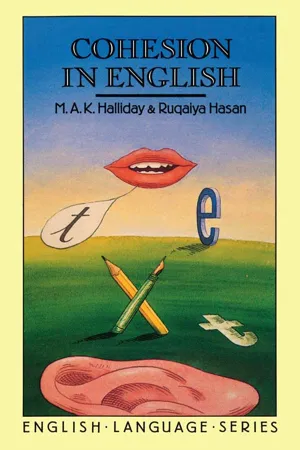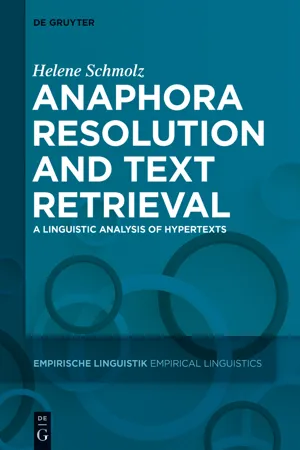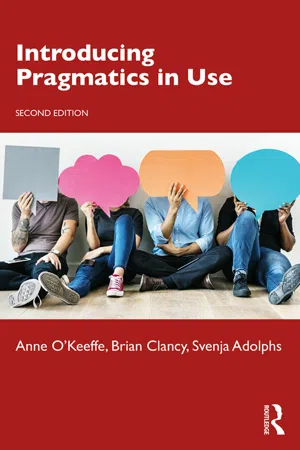Languages & Linguistics
Endophoric Reference
Endophoric reference is a linguistic term that refers to the use of language to refer to something within the same text or discourse. It is a way of creating cohesion and coherence within a text by using words or phrases that refer back to something that has already been mentioned. Endophoric reference can take many forms, including pronouns, demonstratives, and lexical repetition.
Written by Perlego with AI-assistance
3 Key excerpts on "Endophoric Reference"
- eBook - ePub
- M.A.K. Halliday, Ruqaiya Hasan(Authors)
- 2014(Publication Date)
- Routledge(Publisher)
There are of course many other aspects to restricted code than a high frequency of exophoric reference. But one of the principal characteristics of restricted code is dependence on the context, and the exophoric use of reference items is one form such dependence takes.A reference item is not of itself exophoric or endophoric; it is just ‘phoric’ – it simply has the property of reference. Any given INSTANCE of reference may be either one or the other, or it may even be both at once. We shall see in this chapter that there are tendencies for particular items or classes of items to be used exophorically or endophorically; but the reference relation is itself neutral: it merely means ‘see elsewhere’. On the other hand, as we have emphasized already, only Endophoric Reference is cohesive. Exophoric reference contributes to the CREATION of text, in that it links the language with the context of situation; but it does not contribute to the INTEGRATION of one passage with another so that the two together form part of the SAME text. Hence it does not contribute directly to cohesion as we have defined it.For this reason we shall take only little account of exophoric reference, not attempting to describe it in detail but bringing it in where it relates to and contrasts with reference within the text. We shall treat ‘endophoric’ reference as the norm; not implying by this that it is the logically prior form of the reference relation, but merely that it is the form of it which plays a part in cohesion, and which therefore has priority in the context of the present study. At the same time, however, where we identify TYPES OF REFERENCE and REFERENCE ITEMS in the language, we do so on the criterion of reference potential without regard to the endophoric/exophoric distinction. A reference item is any one which has this potential, and a systematic account of the different types of reference and their place in the linguistic system has to be based on the generalized concept of reference and not on the particular concrete form that it takes when incorporated into the text. - eBook - ePub
- Helene Schmolz(Author)
- 2015(Publication Date)
- De Gruyter(Publisher)
Finch (2005), in contrast, states that deixis is both exophoric and endophoric. He explains that “[one] form of deixis is EXOPHORIC in character in that it is situationally, or contextually, bound. A secondary form of deixis is ENDOPHORIC and serves to locate items textually” (ibid.: 210-211). The latter occurs in examples such as (19), in which this refers to the following sentence and so is cataphoric while being deictic in Finch’s point of view. In this book, this in (19) is a case of a cataphoric interpretation. (19) Keep this in mind: you must not smoke. All in all, the tendency is to see deixis as exophoric and anaphora as endophoric (cf. Green 2006: 417). This could go back to the fact that the words exophora and endophora by Halliday & Hasan (2008) did not come into extensive use but are instead frequently replaced by deixis and anaphora (cf. Vater 2005: 18). For instance, Huddleston & Pullum’s The Cambridge Grammar of the English Language (2010) includes a chapter called “deixis and anaphora”, rather than “exophora and endophora”. 2.4 Anaphors as cohesive devices in texts Anaphors linguistically belong to the concept of cohesion. Anaphors are cohesive devices because they establish relations between linguistic elements in texts and therefore contribute to the cohesion of a text. Therefore, this chapter investigates cohesion and other basic concepts of text linguistics. Finally, the role anaphors play in reducing texts will be discussed. 2.4.1 Texts and their features As this book analyses texts, the question of what a text is will now be examined. To start with, there is no agreed definition of the term “text” among linguists. In a strict sense, “text” only refers to written forms of language, which is also consistent with the way “text” is used in everyday language. Yet, it can also be used for spoken forms of language (cf. Matthews 2007: 405-406). Instead of text, the word discourse is often used synonymously (cf - eBook - ePub
- Anne O'Keeffe, Brian Clancy, Svenja Adolphs(Authors)
- 2019(Publication Date)
- Routledge(Publisher)
You will find some friends here points forward in the text to the group of people Mr Knightly will meet when he enters the room.4.2 DeixisThe main focus of this chapter, deixis , falls under the domain of exophoric reference. Derived from the Greek word for ‘pointing’ or ‘indicating’ (deiktikos ‘apt for pointing with the finger’), deixis enables interlocutors to refer to entities in context, thereby allowing them to identify people and things in relation to the space in which they are operating at the moment at which they are speaking. Table 4.1 has briefly introduced a number of items that encode deixis, for example, the first and second person pronouns I and you ; the demonstrative use of that ; adverbs of space such as there ; and other grammatical features such as tense markers. These items that encode deixis are commonly referred to as deictics (marked in bold in extract 4.3).(4.3)[Context: Recording takes place in the home between intimates. Speakers are numbered according to their appearance in the extract.] <$1> well the various cross-channel ferries have been cancelled for today into tomorrow because of this storm <$2> oh right <$1> yeah (Spoken BNC2014: Text S263) The meaning of deictic items today and tomorrow can only be retrieved from the context of the situation. Therefore, we have no way of knowing the time reference for today or, indeed, for tomorrow unless we were present when the words were spoken.1
Index pages curate the most relevant extracts from our library of academic textbooks. They’ve been created using an in-house natural language model (NLM), each adding context and meaning to key research topics.
Explore more topic indexes
Explore more topic indexes
1 of 6
Explore more topic indexes
1 of 4


